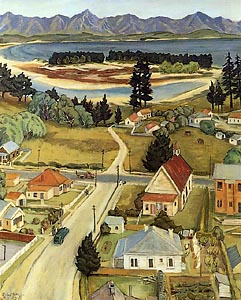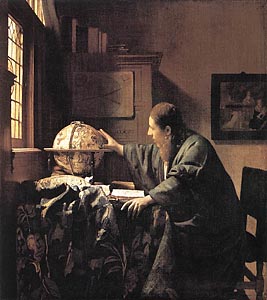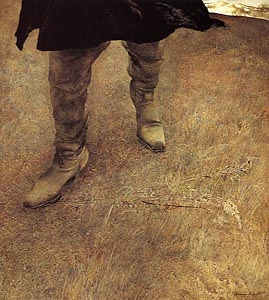| |
Grahame Sydney is an artist based in Central Otago, New
Zealand. He is best known for his superlative landscapes,
interpreting this area.
Otago is a southern region on New Zealand's South Island, and
includes the coastal city of Dunedin. Central Otago is the
inland portion of
 this
region. Historically it was the center of a gold rush during
the 1860s, and as a result Dunedin became the largest city in
New Zealand for two decades. After the gold rush, the area
turned to sheep raising and fruit production. The red tussock
grass (Chionochloa
rubra)
that predominates on the Central Otago elevated plateau gives the area
its distinctive, unusual reddish color. The semi-arid
flatlands, scarred by glacial valleys, combine and contrast with numerous mountain ranges
to offer picturesque vistas. this
region. Historically it was the center of a gold rush during
the 1860s, and as a result Dunedin became the largest city in
New Zealand for two decades. After the gold rush, the area
turned to sheep raising and fruit production. The red tussock
grass (Chionochloa
rubra)
that predominates on the Central Otago elevated plateau gives the area
its distinctive, unusual reddish color. The semi-arid
flatlands, scarred by glacial valleys, combine and contrast with numerous mountain ranges
to offer picturesque vistas.
The varied topology of the South Island has made it a
compelling subject for landscape artists over the years. Among the
notable painters active in various areas of the South Island
(sometimes called "The
Mainland") were Rita Angus and
Doris Lusk, particularly in the 1930s, 40s and 50s. Both portrayed
scenes of Central Otago. Their work often shows some obvious similarities to
the
Regionalist art painted in the U.S., Canada and Australia during these
years, with the strongest influence appearing to come from the work
of Grant Wood. The image above is of a painting by Doris Lusk.
Click here to visit a gallery of landscape art from New Zealand.
The development of a national identity in New Zealand's art
dates back to the landscape art of the early 1930s, with
Taranaki (1931) by Christopher Perkins often cited as the
model for Regionalist Realism. Although many artists in the following decades were influenced by the
Abstract movements, the traditions of Realism remained in
tact. By the late 1960s, new trends of Realism
began to flourish throughout the U.S. and Canada. In New Zealand,
a young Grahame Sydney was a student at the Otago
School of Art. He found a great admiration for the paintings of
Vermeer and other Dutch masters of the
Golden Age, as well as the earlier art of
Albrecht Dürer
and
Jan van Eyck. After graduation, he moved to England and traveled
some in Europe. He soon returned to New Zealand, but during
his time in London he was able to learn the
tedious techniques of egg tempera painting. These techniques
provide an artist with tonal control and an ability to
render fine details, both important to landscape painting.
following decades were influenced by the
Abstract movements, the traditions of Realism remained in
tact. By the late 1960s, new trends of Realism
began to flourish throughout the U.S. and Canada. In New Zealand,
a young Grahame Sydney was a student at the Otago
School of Art. He found a great admiration for the paintings of
Vermeer and other Dutch masters of the
Golden Age, as well as the earlier art of
Albrecht Dürer
and
Jan van Eyck. After graduation, he moved to England and traveled
some in Europe. He soon returned to New Zealand, but during
his time in London he was able to learn the
tedious techniques of egg tempera painting. These techniques
provide an artist with tonal control and an ability to
render fine details, both important to landscape painting.
In the mid 1970s Sydney began an extensive interpretation of the
landscapes of Central Otago, its grasslands and mountain
ridges. What is remarkable about his paintings is that they
are mostly void of the human figure, but at the same time
they almost always display the hand of man. Collectively his art
represents many semiotic pieces of a large puzzle, always
giving clues about the artist's environment and his worldview, but never
providing outsiders complete photographic revelations of his
terra veritas.
His works has been mature from the beginning and always technically
superb. The accessibility of the vernacular
structures, which are so often present in his paintings,
blends with the timeless attributes of the terrain.
The remoteness of these vistas provides the viewer with a temporary
reprieve from the anxieties stemming from an ever increasing saturation
of the media.
A revival of the tempera techniques occurred in North America
between 1930
 and
1960. The artists who took up egg tempera in the 1930s
included Isabel Bishop, Ben Shahn, Peter Hurd and O.Louis Guglielmi .They were followed by Jared French, Paul Cadmus, Andrew
Wyeth and George Tooker in the 1940s, and Robert Vickrey and
Alex Colville in the 1950s. Inspired by the work of these
artists, Grahame Sydney make a decision to follow their
footsteps and to apply egg tempera techniques to landscape
painting. In particular his work seems to be informed by Wyeth. Sydney taps into similar themes of indigenous
architecture and isolation. Thematic explorations spawn
metaphoric imagery, and perhaps nostalgic reflection. Thus the
strength of this art lies in a capacity to evoke through
hidden meaning or narratives deposited inside of it.
This capacity is the heart of Regionalism, a diverse and often stylized
type of art, rooted in the Depression era, which lost much of
its status with the advent of World War II and the emergence
of Abstract Expressionism. Yet in the work of
Sydney we see a
metamorphosis
to an elevated level of Realism, one which transcends its
regional bedrock. and
1960. The artists who took up egg tempera in the 1930s
included Isabel Bishop, Ben Shahn, Peter Hurd and O.Louis Guglielmi .They were followed by Jared French, Paul Cadmus, Andrew
Wyeth and George Tooker in the 1940s, and Robert Vickrey and
Alex Colville in the 1950s. Inspired by the work of these
artists, Grahame Sydney make a decision to follow their
footsteps and to apply egg tempera techniques to landscape
painting. In particular his work seems to be informed by Wyeth. Sydney taps into similar themes of indigenous
architecture and isolation. Thematic explorations spawn
metaphoric imagery, and perhaps nostalgic reflection. Thus the
strength of this art lies in a capacity to evoke through
hidden meaning or narratives deposited inside of it.
This capacity is the heart of Regionalism, a diverse and often stylized
type of art, rooted in the Depression era, which lost much of
its status with the advent of World War II and the emergence
of Abstract Expressionism. Yet in the work of
Sydney we see a
metamorphosis
to an elevated level of Realism, one which transcends its
regional bedrock.
It might be productive to compare Grahame Sydney's art to that
of another earlier type of Realism, that being Precisionism.
This may seem an unlikely comparison, given that the main
proponent of Precisionism, Charles Sheeler, was known for his
preoccupation and veneration of the culture of Industrialism.
However, other artists often associated with this movement
clearly rejected these aspects in favor of a more rural
outlook. And even within Sheeler's oeuvre there is a dualism
of subject material, and a significant rural component. We
should call this aspect Rural
Precisionism. Within this earlier art one can see the
early seeds of the branch of Realism that bore fruit in the
1970's, a type of art that can be referred to as High Realism.
We invite you to visit the Grahame Sydney Gallery at Monograffi Fine Art Galleries. We hope that you will enjoy the
work of a modern master.
Grahame Sydney's Gallery
Artist's Web Site:
http://www.grahamesydney.com
|
|